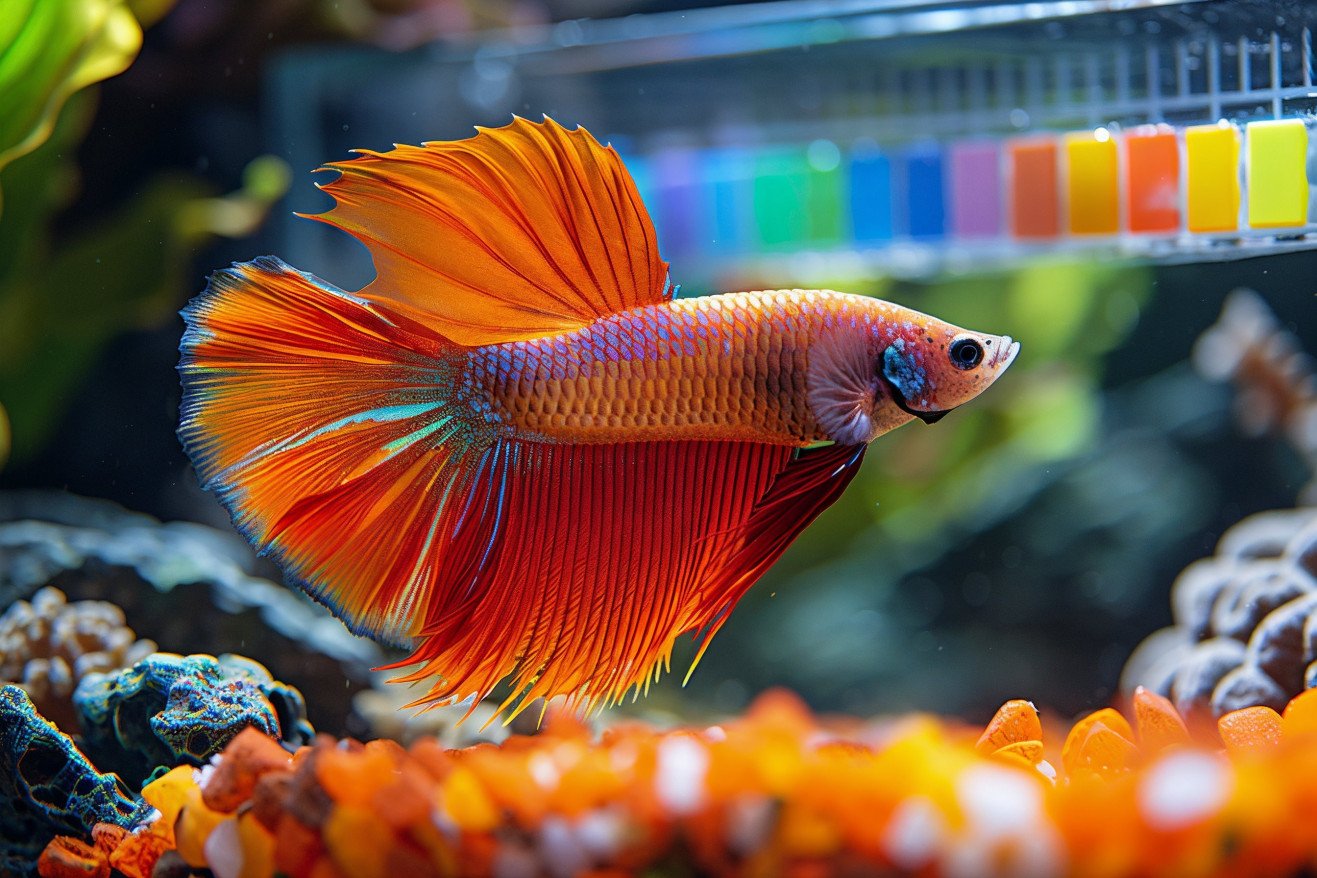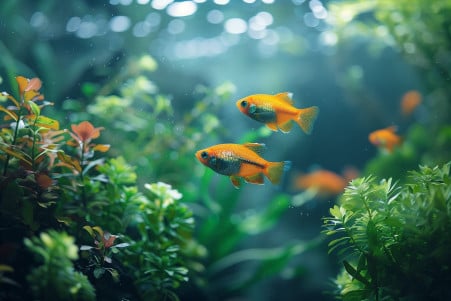How to Increase Aquarium pH: Safe & Effective Ways
5 March 2024 • Updated 4 March 2024

Aquarists often feel frustrated and worried when they encounter low pH in their tanks. To increase pH in an aquarium, you can slowly add baking soda, use crushed coral or aragonite sand, and add limestone or coral rocks. It’s also important to change the water regularly and use test kits to check the pH. Make sure to avoid sudden pH changes that can harm fish and other animals.
This article combines information from aquaculture, chemistry, and the experience of seasoned aquarists to take a deep dive into the topic. We will start by looking at the science behind water pH and then move on to the best and most reliable ways to increase pH in your tank.
We will also explore research on the impact of different substrates, buffering agents, and ornaments on water chemistry. By the time you finish this article, you will have the information you need to ensure a stable and healthy environment for your underwater pets.
What are safe and effective ways to increase pH in an aquarium?
Why pH Is Important in Aquariums
pH is a measure of the acidity or alkalinity of the water in your aquarium and is an important factor in creating the right environment for your fish. As Aqueon explains, pH is measured on a scale of 0 to 14, with 7.0 being neutral. Anything below 7.0 is acidic, and anything above 7.0 is basic or alkaline.
This seemingly small difference is important because it impacts the biological processes and overall health of fish, invertebrates, and plants. In fact, a change in pH that moves too far from an organism’s preferred range can cause stress or even death in the aquarium.
Fish and plants have adapted to live in certain pH levels, and the closer you can get to the pH of their natural environment, the better. For example, most freshwater tropical fish, including popular species like tetras, do best in slightly acidic to neutral water (pH 6.8 to 7.8).
On the other hand, African Cichlids need more alkaline water (pH 8.0–9.0), according to Aqueon. Meanwhile, an article in Sciencing explains that very low pH levels can be toxic to fish, causing damage to their skin and other tissues.
pH levels drop as mineral buffers are used up and organic waste builds up. Biological activities like nitrification and plant respiration also contribute to changes in pH, which is why it’s important to test your water regularly and manage your tank carefully. As you work to maintain a healthy balance in your tank, moving to more natural methods of adjusting pH is a logical next step.
Using Natural Methods to Increase Aquarium pH
Instead of using chemical solutions that provide temporary relief, natural methods to adjust pH are safer and more stable ways to increase alkalinity in your aquarium. One of the best ways to increase your aquarium’s pH is by using substrates like crushed coral or aragonite sand. These substrates will help your tank’s pH gradually become more alkaline by leaching important minerals into the water that will counteract acidity.
In addition, if you decorate your aquarium with limestone or coral rocks, it can help you in two ways. Not only will it make your tank more visually appealing, but it will also help you maintain a stable pH. Limestone and coral rocks release carbonate into the water, which naturally buffers and stabilizes pH levels, ensuring that your fish and other aquatic life have a stable environment.
While these methods may seem simple, it’s important to remember that you should always make changes to your aquarium gradually. If you make changes too quickly, you can shock your fish and other aquatic life, leading to stress and even death. This means that you should start by adding small amounts of these substances and then use a reliable test kit to monitor pH levels, according to Algone.
With time and careful observation, these natural methods can help you establish a healthy ecosystem and prepare you to introduce buffering agents that will further help you stabilize pH, according to Algone.
What Are Buffering Agents and How Do They Impact pH?
Buffering agents are compounds that help stabilize the pH of a solution, such as aquarium water, by neutralizing acids or bases. This is especially important in aquascaping, where pH changes can be harmful to the plants and animals living in the tank.
One common buffering agent used in aquariums is sodium bicarbonate, or baking soda. A study in VIN found that sodium bicarbonate is used by aquarists to prevent pH drops when using anesthetics in fish.
A study in ResearchGate found that a number of buffers, including sodium bicarbonate and TRIS, were effective in maintaining the pH of seawater close to normal. This is especially important during fish transportation, where stress and respiration can lead to a rapid decline in water quality.
It’s important to add buffering agents to an aquarium slowly, at low concentrations, and to monitor the pH of the water closely, as sudden changes can be harmful to the fish. Taking this slow and steady approach will ensure the health of the fish and help maintain a healthy, balanced underwater environment.
Balancing Act: Decor and Plants in pH Control
Aquarium decor does more than just make your tank look pretty; it also plays a role in helping to control the pH of your tank. For example, driftwood can help lower the pH of your tank by releasing tannic acids into the water, which can help create a safe space for fish that prefer more acidic water.
On the other hand, rocks like limestone can help raise the pH of your tank by releasing minerals that increase alkalinity, says The Aquarium Life.
Plants also play a big role in pH control. According to the CO2Art Aquascaping Experts, when plants take in carbon dioxide, they also take in carbonic acid, which can help lower the pH of the water. This means that the role of plants in pH control is another reason why it’s important to choose the right plants for your tank.
For example, Amazon swordplants prefer soft, acidic water, so they’re a good option for tanks with lower pH levels, while Egeria can be grown in hard, alkaline water, so it’s a good option for tanks with higher pH levels.
When choosing decor and plants for your tank, it’s important to think about how they will affect the pH of the water and choose them based on the needs of the fish and other aquatic life in your tank.
It’s also important to make sure you’re keeping an eye on the pH of your tank so you can make sure any decor or plants you add aren’t having a negative impact on your tank’s ecosystem. If you do this, you should be able to create a tank that has a healthy, balanced pH.
The Importance of pH Testing and Adjustment
Because the pH of an aquarium can change for a number of reasons, it’s important to stay on top of pH testing. Modest Fish notes that regular pH testing should not be thought of as a chore but as an important part of taking care of your aquatic pets.
There are several different pH test kits available to aquarium owners, from simple paper strips to more complex digital pH meters. However, while each type of test kit has its own benefits, they all aim to give you accurate information that you can use to care for your tank.
If you need to adjust your tank’s pH, make sure to test your water with your chosen test kit first. If you need to make changes, it’s best to start with natural methods like adding aragonite sand or carefully using tap water with the correct pH to change out some of the water, according to Aqueon and Modest Fish.
No matter what, make sure that any changes you make are done slowly to avoid big swings that could stress the animals in your tank.
When it comes to regular maintenance, make sure that you have a schedule that includes weekly water testing and changes. This will help you avoid the build-up of waste and uneaten food, which are two of the main causes of low pH, according to Modest Fish.
This kind of regular maintenance will help ensure that your tank is healthy and stable in the long term, giving the animals in your tank the best chance to thrive.
How to Balance Your Aquarium’s pH: A Recap
Balancing your aquarium’s pH is a matter of making sure that the water is safe and healthy for all of the creatures living inside. This article has covered the importance of monitoring and adjusting pH levels, shown how natural methods are the safest and most effective ways to raise pH, and explained how buffering agents and aquarium decor can help keep pH levels stable.
A stable pH is important for the health and happiness of every living thing in your aquarium, from the tiniest bacteria to the largest fish. By using substrates like crushed coral, employing buffering agents like baking soda, and choosing the right decor and plants, aquarists can help maintain a healthy pH in their tanks, all without the risks of chemical treatments.
It’s important for every aquarist to take an active role in managing pH levels. This means regular testing, small changes, and constant upkeep. As aquarists continue to build and maintain their tanks, they should look to nature to help them create a beautiful underwater ecosystem that will thrive with the right care.


